Finding arguments for setting up a project management office (PMO) is easy at first. After all, you are aiming to economize by making project handling more efficient and successful. It becomes more complicated once you have to prove that the PMO is actually profitable for the company. But how can you create PMO KPIs? How do you measure its value? And its acceptance?
In this article, you will learn how to go about creating KPIs for the PMO and what to pay attention to.
- PMO Types and Possible Areas of Responsibility
- PMOs Must Have a Measurable Effect
- PMO KPIs – How to Prove the PMO Value
- What You Should Take into Account When Measuring
- How to Introduce Project Management KPIs
- Conclusion
Special Download: How to setup a PMO in 4 simple steps (PDF file)
Please fill in the form.
* Required Fields | Data Protection
First, we will take a brief look at different types of PMOs and their possible tasks.
What is the reason for this? Depending on the requirements, a PMO can have:
- A different structure
- An individual position in the organization
- Diverse areas of responsibility
Not all PMOs are the same. All the more reason to create individual assessment processes regarding its additional value.
Accordingly, the value cannot be determined using one single method. Rather, it comes down to reflecting about individual ways of measuring the PMO’s additional value in your company. This will allow you to put together an assessment process appropriate for your environment.
Special Download: 10 Vital PMO Success Factors (PDF file)
Please fill in the form.
* Required Fields | Data Protection
PMO Types and Possible Areas of Responsibility
We distinguish between the following three types of PMO:
- Individual Project Office for a large project (PO)
- Central Multi-Project Management Office (PMO)
- Strategic Project Management Office (SPMO)
Learn about the concept of the Agile PMO in this related article.
Depending on the type of company and the nature of your project management maturity level, the PMO can be assigned different tasks.
The following graphic differentiates between 5 areas of responsibility:
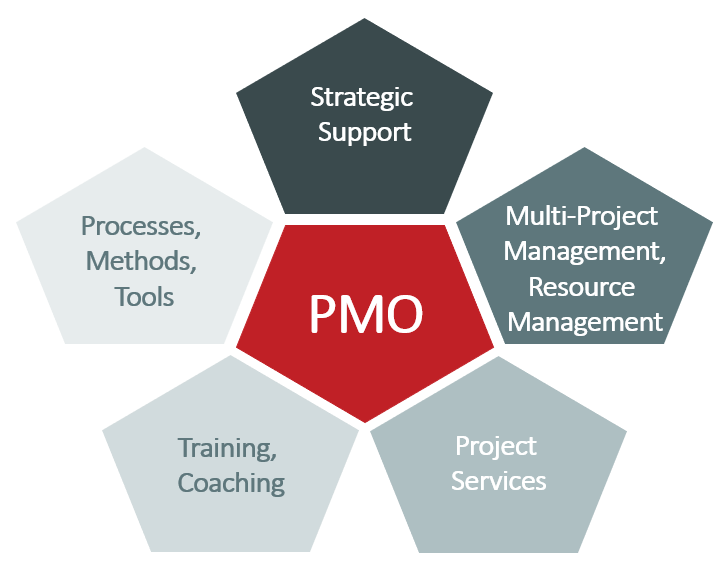
Strategic Support:
This refers to the PMO’s involvement in strategic project management, e.g. setting up and implementing project selection and prioritization processes, conducting efficiency analyses, determining PM conditions.
Processes, Methods, Tools:
The PMO has to define and maintain processes, PM methods and tools.
Training, Coaching:
The implementation of staff development measures for project managers and teams is another cornerstone of PMO responsibilities.
Project Services:
Another PMO responsibility is operational support for projects in implementing PM tasks (e.g. workshop moderation, temporary provision of a project controller).
Multi-Project Management, Resource Management:
Examples of this are monitoring project progress and implementing control measures, gathering and preparing project information for decision-making bodies, strategic capacity planning, resource management.
You might also like our article about the Strategic PMO of the Future.
We surveyed the 215 attendants of one of our webinars in March 2019 asking: “What are the responsibilities of your PMO?” The result showed the following weighting of the areas of responsibility (multiple choice was possible):
- 80% = Methods and Processes
- 65% = Project Services
- 51% = Project Portfolio Controlling
- 51% = Training and Coaching
- 41% = Strategic Project Management
PMOs Must Have a Measurable Effect
Often the PMO’s share in the company’s success is neither measured nor communicated sufficiently. This can lead to the perception that PMOs are not benefitting the company noticeably, if at all.
To find out about the state of the PMO, we conducted an in-depth survey in Germany, Austria and Switzerland in 2020. We surveyed 588 individuals from 450 different companies, 73% of which already had a PMO.
We asked them to rate their satisfaction with the PMO. Only 5% of the participants were very satisfied. The majority (63%) was satisfied but saw minimal need for improvement. The remaining 32% were dissatisfied and wished to see significant improvements.
In our study, we also divided the respondents into three groups depending on their performance level, i.e. low performers, high performers and top performers. We assigned the companies to the groups according to their responses to questions regarding compliance with deadlines, budgets and quality requirements.
Among the top performers, the proportion of “very satisfied” respondents was much higher (20%). They were three times as satisfied as high performers and seven times as satisfied as low performers.
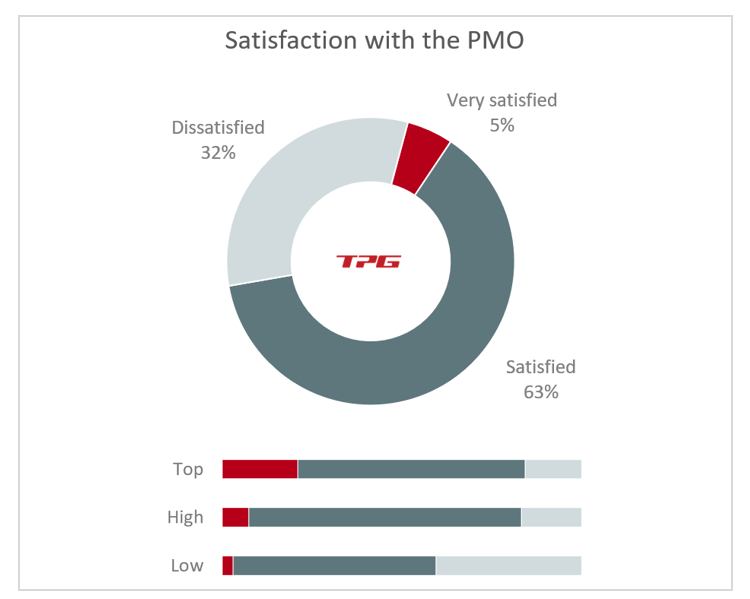
The survey arrived at another interesting conclusion. It appears that the longer the PMO has existed, the greater the positive influence on the companies’ project management. Top performers were most likely to have had their PMO for more than five years.
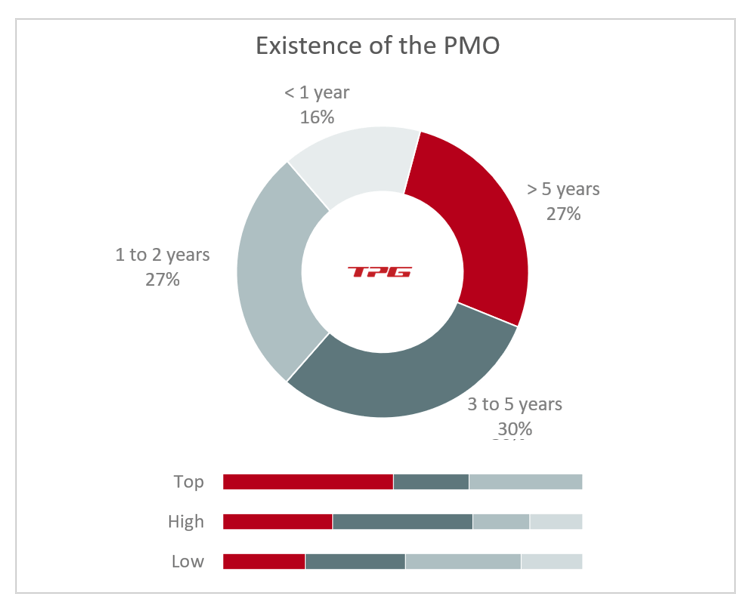
Satisfaction with the PMO is directly related to the PMO’s ability to successfully manage projects, how long the PMO has been in existence, and the number of PMO employees.
PMO Study 2020: Part 1, p. 21
Can this feeling of having a highly beneficial PMO actually be measured using KPIs? And can the value be attested? This article demonstrates how you can assess the benefits provided by your PMO with KPIs. The results should enable you to make the right improvements and thereby increase the lifespan and performance of your PMO.
Find out more about TPG’s extensive PMO Study 2020 here.
PMO KPIs – How to Prove the PMO Value
A Key Performance Indicator (KPI) is an index reflecting the success, or rather the performance, of an organizational unit such as a PMO.
Looking to successfully set up a PMO? Check out our detailed guide!
To prove the value provided by your PMO you should:
- Define a set of key project performance indicators (PMO KPIs).
- Align these with your stakeholders.
This is likely to increase your chance of a long-lasting existence.
Below, you will find qualitative and quantitative topics for measuring the additional value. You can use them as a basis for your assessment process. Essentially, you can distinguish three areas:
- The work of the PMO
- The acceptance of the PMO
- The results affected by the PMO
1- The Work of the PMO
The chart below shows how to take quantitative measurements regarding your PMO’s work and maturity level. All examples allow measuring – and thus can substantiate the development and the success of the PMO.
Areas for the measurable quantities allowing for KPI mapping are accordingly:
- Completeness of lists, reports etc. (projects and reports consistently available?)
- Currency of data, reports etc. (all project updated within the timeframe?)
- Training level of the employees (training completed?)
- Support by the PMO (no ticket open longer than agreed?)
- Stakeholder acceptance of the PMO (survey with good results?)
- Establishment and documentation of the method (documentation complete and available?)
Let us use the list of active projects as an example. Your company currently has 100 active projects, but only 80 are recorded in the project list. Some of them may be missing values for traffic light indicators, cost etc. In addition, more than half of them may have a status report older than 4 weeks.
Read more about the Importance of Meaningful and Up-to-Date Project Status Reports
Thus, you have a measurable need for improvement.
You should be able to judge most topics by assessing the current stock of data.
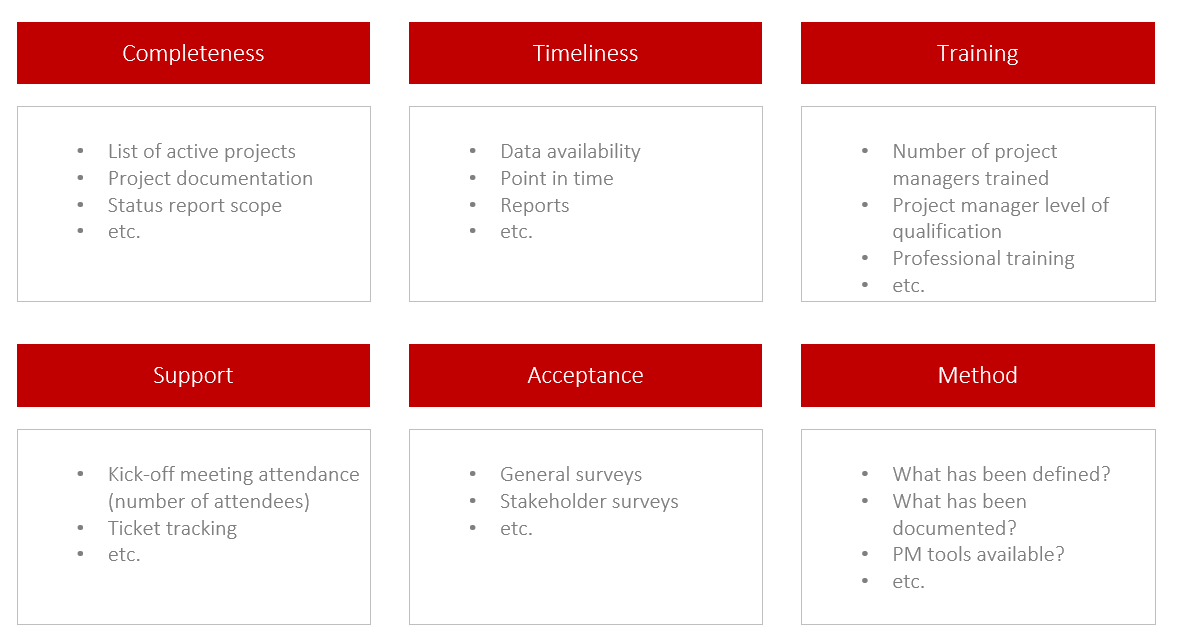
2- The Acceptance of the PMO
The PMO’s acceptance is a different thing altogether. The only way to find out how the work of the PMO is actually viewed are repeated surveys of the stakeholders.
Unhappy with the current level of acceptance? Learn how to increase PMO acceptance.
You could ask the following questions:
- Overall, are you satisfied with the service of the PMO?
- Are you happy to use the services of the PMO?
- Do you consider the PMO’s response time adequate?
- Does the PMO mean a saving of time for you?
- Does the PMO bring assistance to you?
- Do you find out about priorities in the portfolio?
- Do you feel the PMO supports you in the case of resource conflicts?
- Do you find the specified PM methods useful?
- Is the PM documentation sufficient?
- Is the training provided helpful?
3- The Results Affected by the PMO
If a PMO’s work is successful, it will also contribute to corporate success. However, this circumstance is harder to measure than the topics presented above. This is about measuring the effects. Often, the latter can only be noticed indirectly.
For instance, increasing the project output could be a desirable goal. It will be easy for you to determine the number of successfully completed projects in a portfolio, e.g. per year.
Yet, such a number can only be of limited value. This is due to the differences between the projects (complexity, duration, effort, cost …). Always bear this in mind!
In our 2020 PMO survey mentioned above, we differentiated between the quantitative and the qualitative assessment of the benefits of the PMO.
For the quantitative assessment, we asked the question “Which of the following project-related data do you use to determine the quantitative benefit provided by your PMO?”
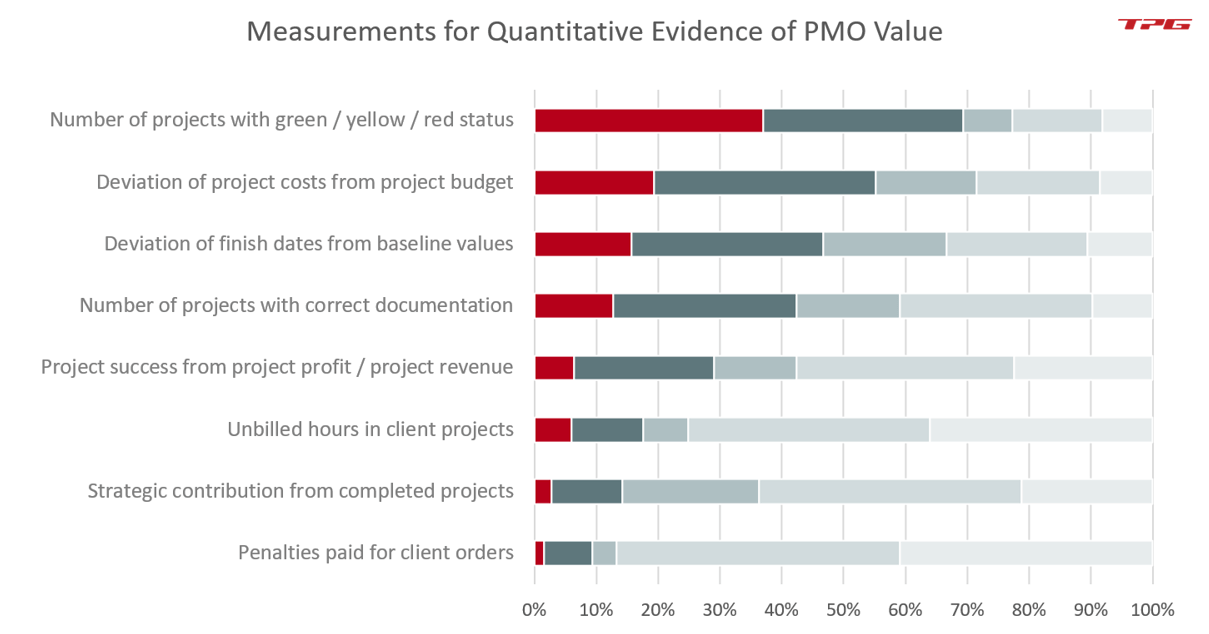
Questions you could assess in this context include:
- What is the number of projects with green / yellow / red status?
- How far do project costs deviate from the respective project budget?
- To what extent do project finish dates vary from the related baseline values?
- What is the number of projects with correct documentation?
- What was the project success from project profit / project revenue?
- What is the number of unbilled hours in client projects?
- What has been the strategic contribution of completed projects?
- How high / many were the penalties paid for client orders?
Measurements of the quantitative benefit are more widespread among companies, as these are easier to measure than the qualitative benefits. Our PMO study also found that high performers were far ahead of low performers in taking quantitative measurements.
Still, measuring the qualitative benefits is also valuable. In out PMO survey, we asked the respondents whether they regularly surveyed the stakeholders with this purpose. Again, top and high performers were ahead of low performers when it came to taking these measurements.
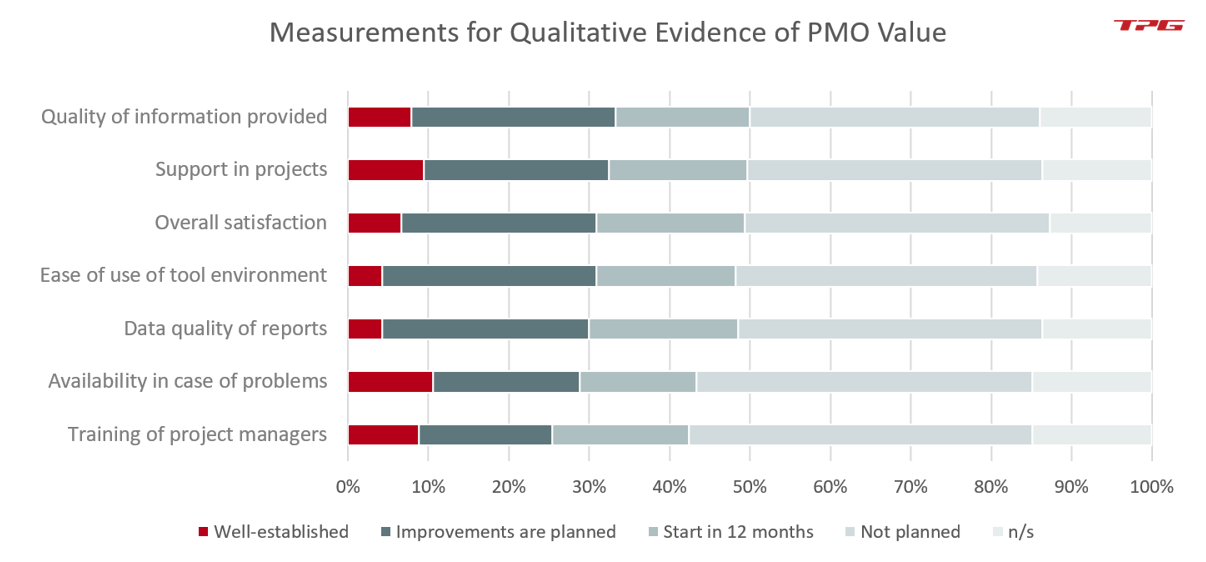
For the stakeholder survey aiming for qualitative evidence, we propose questions regarding different topics. For example:
- How would you rate the quality of the information provided by the PMO?
- Does the PMO provide helpful support in projects?
- How would you rate your overall satisfaction with the PMO?
- Is the tool environment easy to use?
- What is your impression of the data quality of the reports?
- How is the PMO’s general availability in the event of a problem?
- Does the PMO provide good training and staff development measures?
A 2013/2014 PMO study by the German Association for Project Management (Deutsche Gesellschaft für Projektmanagement, GPM) dealt explicitly with the assessment of PMO success. The study listed five areas to measure if you want to determine a PMO’s success:
- How well do people follow the defined project management process?
- How high is the level of target achievement for the projects in the portfolio?
- How well can you control the project portfolio (level of controllability)?
- What is the feasibility of the planned project portfolio?
- How good is the maturity level of projects in the planned portfolio?
What You Should Take into Account When Measuring
Note that there is one essential prerequisite for measuring improvements. Record the initial state. Document it by all means to allow you to compare states later on.
Regular measurements will ensure you can document the changes based on this. The recorded initial state will also permit you to demonstrate the developments. In addition, it is an important basis for determining the maturity level.
PMO members can either conduct surveys and measurements themselves. Otherwise, external consultants can take on the job. With external support, you will increase the acceptance of the survey results within the company. After all, there will be no self-evaluation by the PMO.
Special Download (PDF): What are typical PMO Functions? (+ their importance)
This article provides you with a good comparison as well as ideas for functions you could consider next for your PMO. Please fill in the form to download.
* Required Fields | Data Protection
How to Introduce Project Management KPIs
Pick those key performance indicators from the list above which you consider relevant for your needs.
Next, you should align this selection with your stakeholders. At the same time, you need to settle how often you are going to report the current values of these indicators.
Over time, the PMO’s area of responsibility will also change. This will be due to corresponding changes in maturity level and targets. One thing you should be prepared for: defining the assessment process will not be a one-off.
By determining the topics for evaluation, it often becomes easier to define the task field.
Make the results of evaluation or surveys available to all employees – preferably in the PMO portal. Make no secret of it.
Take countermeasures, if a development in the wrong direction becomes apparent.
Document the measures you plan and take so that the PMO comes across as active and transparent.
Your project environment is sure to be dynamic. The PMO cannot be seen to lag behind. Create an awareness of the PMO value by regular and active reporting.
Celebrate project successes. And get positive statements from project managers and other stakeholders stating how they profited from the PMO.
Conclusion – How to Create PMO KPIs
This article has shown that the value of a PMO cannot be determined with a single method. Rather, it is necessary to take into account the individual PMO responsibilities in your company.
We have listed suggestions for measuring the individual additional value of your PMO. You have also learned what to keep in mind when measuring. In this case, the measurable quantities are:
- Work
- PMO acceptance
- Results affected by the PMO
Out of these, you should put together an assessment process appropriate for your environment.
Our final tips
Get to know the individually adaptable “PPM Paradise” – the optimal environment for your enterprise-wide project, program, portfolio and resource management. Download the eBook now (just click, no form).
And sign up for our bi-weekly blog newsletter to make sure you receive all our updates.
Did you like this article? What is your approach to demonstrating the value and acceptance of your PMO? We also welcome other examples of PMO KPIs. Please use the comment area below.
Subscribe to TPG BlogInfo: Never miss new practice-oriented tips & tricks
Every other week: Receive practical tips in TPG blog posts written by recognized experts in project, portfolio, and resource management.
* Required Fields | Data Protection
 Johann Strasser
Johann Strasser
Managing Partner at TPG
The certified engineer, has been a managing partner at TPG The Project Group since 2001. After many years as a development engineer in the automotive and energy sectors, Johann Strasser spent a decade as an independent trainer and consultant in the field of project management. During his tenure, he also served as project manager for software projects in the construction industry and provided scheduling and cost management support for large-scale construction projects. At TPG, he applies his expertise in product development and consulting services for international clients. His special focus is on PMO, project portfolios, hybrid project management, and resource management. For many years now, he has shared his knowledge through presentations, seminars, articles, and webinars.
Read more about Johann Strasser on LinkedIn and XING.
 Achim Schmidt-Sibeth
Achim Schmidt-Sibeth
Senior Marketing Manager
After earning his engineering degree in environmental technology, he gained many years of experience in project management through his work at an engineering office, an equipment manufacturer, and a multimedia agency. Achim Schmidt-Sibeth and his team have been responsible for marketing and communication at TPG The Project Group for many years now.








16 Comments
Something to consider is the ‘seniority’ of the PMO.
Some organizations perceive a PMO as the person who arranges meetings, collects and distributes reports and is responsible for general admin wok around the projects.
Others see a PMO as something that can only be done by someone who is a ‘senior project manager’. The PMO is then use to analyze reports produced by the PMs, check their project files and progress an generally used to ensure that the PMs do their jobs.
The KPIs will the vary accordingly.
Hessel, thank you so much for your valuable comment. The KPIs with which we assess a PMO’s value vary depending on the company and the individual responsibilities of the PMO. As you outlined above, a PMO’s seniority will also affect its responsibilities and therefore the KPIs.
In “Step 2” of the article https://www.theprojectgroup.com/blog/en/how-to-set-up-a-pmo/, we go into detail about the possible areas of responsibility of a PMO.
We also believe that, with rising project management maturity, PMOs will have an increasingly strategic role and fewer support tasks. If you want to know more about this idea, check out the article https://www.theprojectgroup.com/blog/en/pmo-of-the-future/.
Hello,
One of the things that I wonder related to the items identified increasing the acceptance of a PMO is the main reasons on why a majority of the lifespan of the PMO is just between 2 – 4 years.
As part of the KPI measurement it is referenced to have discussions with the stakeholders to select the adequate measurements and adapt to the dynamic changes impacting the organization, which seems to all come together in a constant communication and feedback loop, is that correct? If so – would be in your experience the main reason for low acceptance of the PMO (and even the need to identify improvements) the lack of (constant) effective communication?
Dear Marcel van den Eijnden,
Thank you so much for your interesting comment! It inspired me to do a little more research on this topic once again. I hope, of course, that the results of my research will be interesting and exciting for you.
Unfortunately, I was not able to find an empirical study substantiating the claim that in the majority of cases the lifespan of the PMO is between 2 – 4 years. Should you have a source for this claim, please let me know. What I did find were several articles explicitly pointing to the limited lifespan of the PMO. Their authors also used this lifespan as a basis for their deliberations.
Michael Wharton assumes a lifespan of 5.5 years in his article “Time to Reboot Your PMO”. In this context, he explains what could have happened in these 5.5 years: Managers have left the company; new ones have arrived. Project managers try out new methods or plainly question the present system. Hence, Wharton sees the changes in the environment as decisive factors.* The study “The State of Project Management Office (PMO)” points to a (median) lifespan of 3 to 5 years and links this to the performance of the organization. In addition, this study emphasizes the necessity of communicating the value of the PMO.** Cody Baldwin is going along the same lines in his book “PMO Pain”. The fifth mistake he names is the missing communication of the benefits which the PMO brings to the organization.***
My conclusion is that the lifespan of a PMO depends on its success. Successful PMOs live longer, and unsuccessful ones die sooner. After all, who will hold on to an organizational unit that does not thrive? Ultimately, I believe that a central point for the justification of a PMO is its beneficial effect. A PMO has to be able to demonstrate its value and then communicate it effectively. Viewed in this light, the demonstrated value comes first. The communication follows after. Where it gets really sad is when the value of the PMO can be demonstrated but no one knows about it due to “poor” communication. And now we have come full circle from your initial statement.
Best regards
Martin Gösse
* Wharton, Michael: “Time to Reboot Your PMO”, April 17, 2017. https://www.mpug.com/articles/time-reboot-pmo/ (October 4, 2017).
** PM Solutions Research, “The State of Project Management Office (PMO)”, 2014. https://www.pmsolutions.com/reports/State_of_the_PMO_2014_Research_Report_FINAL.pdf (October 4, 2017).
*** Baldwin, Cody: PMO Pain: Why Most Project Management Offices Fail and What to Do About It. Cody Baldwin, 2016.
Hi Martin,
Very interesting discussion! I did a little research myself.
UplandPowerSteering published an interesting article on “PMO Strategy” on their blog: https://uplandsoftware.com/powersteering/resources/blog/pmo-strategy/
According to their experience, “ineffective PMOs normally have a shelf life of four years or less”.
“One reason for the PMO elimination trend may be due to a disconnect between what the business believes the PMO should do and what the PMO actually does. According to the Gartner survey results from the “PMO/Business Disconnect Presents Risks and Opportunities for PMO Managers and Senior PPM Leaders” article, the business and the PMO are far from aligned. This disconnect could be the cause for not only confusion and finger-pointing but also PMO failure.”
According to Gartner, “organizations must constantly change and adapt to respond to the environment surrounding them and successfully deliver on their corporate ambitions. Without engaged PMO managers and PPM leadership, there is a risk of continental drift — that is, an emerging gap between what services and tasks the business wants from a PMO and what the PMO is actually doing. The picture presented in the business view of the PMO survey is not unique. A separate survey of PPM professionals found that nearly half had experienced no more than one significant change to the original set-up of the PMO. Considering that half the PMOs had been in place four years or longer, it suggests that a PMO may struggle to keep up its pace of change with the pace of change elsewhere in the business.”
Our article Why Agile PMOs Are Comparable to Hummingbirds also discusses the average lifespan for the PMO. Check out section 10. Hummingbirds Have a Lifespan of 3 to 5 Years. This ties in well with the above discussion.
Great, Informative article also I would like to suggest a PMO charter template that may help visitors. https://www.techno-pm.com/2017/12/PMO-Charter-Template.html
Late to the discussion I’m afraid, but I’m in the process of setting up a PMO currently, and this, along with other blog articles will be invaluable in assisting me with that task.
Thank you, Jo! We’re very happy to hear that.
Thank you for your article. I’m implementing a PMO right now and I’m evaluating the KPIs to measure its success.
Thank you, that’s good to hear!
Really interesting post!
I love this very much
Thanks, Takem Alexandro. That’s good to know!
I am grateful for this article of yours, and I am eying it at a time where I’m in a process of establishing PMO right now and I’m evaluating the KPIs to measure its success.
Thanks for the feedback, Areeb Amad. Good luck with your PMO setup!